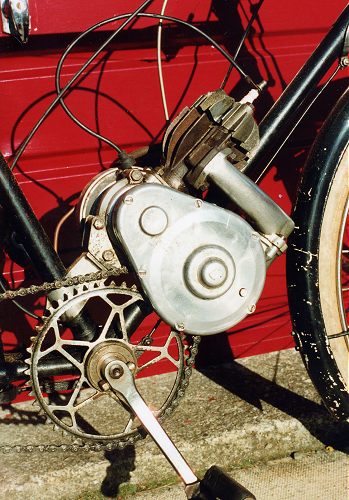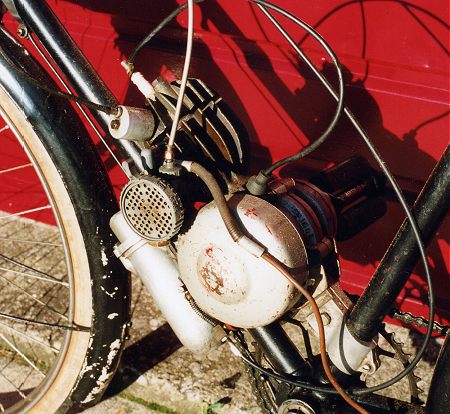 Go
to the Archive index
Go
to the Archive indexIn the early 1950s one of the cheapest and most popular cyclemotor units was the Trojan Mini-Motor. Originally of Italian design but built in Croydon by a Trojan subsidiary, the Mini-Motor had a simple two-stroke engine of 49.9cc producing around 1bhp with direct drive to the rear wheel through a roller fitted to the engine's crankshaft. The power output was enough to propel rider and bicycle up to a top speed of around 30mph. However there were several problems with this simple set up. There was no clutch, so everytime the rider came to a halt the engine had to be stopped, then restarted by pedaling away. On a dry day the set up worked quite well but at the slightest hint of rain, the roller could start to slip and spin on the tyre rather than driving it. Also by being a single geared machine many hills could require pedal assistance from the rider. How could these problems be overcome?

Offside view, clearly showing the
Mini-Motor components and the drive
using the host cycle's existing chain.
In 1953 James Westfield was the owner of a cycle and cyclemotor dealership at 22-24, Lord Street, Grimsby. Grimsby was at that time one of the largest fishing ports in England so the area was well populated with a high level of employment. James Westfield`s business flourished and sold large numbers of cyclemotors, many being Trojan Mini-Motors. Being an engineer, James Westfield decided to design and build his own cyclemotor engine to overcome the shortcomings of roller drive.
His solution was to take a Mini-Motor engine unit and convert it to chain drive. The crankshaft was shortened on the roller drive side and threaded so a toothed sprocket could be fitted. Standard Cyclemaster components were used to make a clutch and reduction gear enclosed within a cast aluminium chaincase. New inlet and exhaust manifolds were also manufactured together with new engine mounting plates and clamps. The modified engine unit could then be fitted to any normal bicycle frame by clamping it to the frame tubes just above the bottom bracket. The engine then drove the rear wheel by chain through the front chainwheel, which was modified by the fitting of a free wheel mechanism in its centre. These fairly simple modifications produced the Simplist cyclemotor power unit.
The Simplist could be fitted to any make of bicycle, lady's or gent's, without any structural alterations to the frame. Fitted above the bicycle's bottom bracket and weighing only just over 26lbs., and with its low centre of gravity the machine was very stable and easy to ride. The pedals were used to start the engine. With a free wheel fitted to the centre of the chainwheel the rider could then freewheel once the engine had started. The chain drive to the rear wheel produced a positive drive in all weather conditions and the simple fitment of a Sturmey Archer 3 or 4-speed rear hub gave a choice of gear ratios making pedal assistance a distant memory. The fitment of a clutch made riding in town a simple process, no more stopping and starting the engine, just pull in the clutch and then ride away with a twirl of the pedals. So with all these improvements over the simple Mini-Motor was the Simplist a success? Sadly the answer is no.

Left-hand side of the Simplist engine
Only three prototype Simplist engine units were ever produced. The first unit was fitted into a gent's bicycle and road tested by none other than Grimsby's own World Motor Cycle Racing Champion, Freddy Frith, who was also a local motorcycle dealer. The Simplist was given a glowing testimony and plans were made to put the unit into production. However by 1953 the cyclemotor boom was coming to and end and demand began to fall. By 1954 the moped was beginning to gain in popularity and the introduction of the NSU Quickly soon finished off what little demand was left for the cyclemotor attachment.
So what became of the three Simplist engine units that were produced? One unit was sold and is known to have been destroyed. The remaining two units were kept by James Westfield until he sold them in 1988 to a friend of mine. One unit was in a dismantled and incomplete state and this was passed on to me. Unfortunately it is practically beyond economical repair. The remaining unit was complete and in running order. This unit is numbered SM 1002 so it is the second prototype originally registered for road use on the 2/10/1953. Engine problems led to the bike being unused until I purchased it in late 2000. I stripped the engine unit and found that the bearing housing for the countershaft in the aluminium chain case had cracked and broken away. This was obviously a design problem as the same damage was evident on the incomplete engine that I already owned. When time allows I intend to have new chain case castings made with a strengthened bearing housing. I can then return the Simplist back to running order and enjoy riding this unique cyclemotor.
First published, December 2003